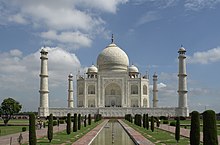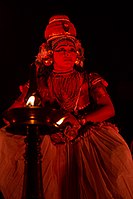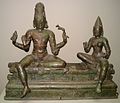Arts and entertainment in India
Arts and architecture in India have had their course shaped by a synthesis of indigenous and foreign influences that have consequently shaped the course of the arts of the rest of Asia, since ancient times. Arts refer to
Architecture

The earliest production in the
With the arrival of Islam, a new style of architecture known as Indo-Islamic architecture emerged combining traditional Indian and Islamic elements. The earliest examples include the Qutb complex, a series of monuments built by successive sultans of the Delhi Sultanate.[3] The architecture of the Mughal Empire includes the Red Fort, Taj Mahal, Agra Fort, Humayun's tomb, Jama Masjid and Fatehpur Sikri.[4][5]
With colonization, a new chapter began. Though the
With the introduction of
- Various examples of Indian architecture
-
Typical South Indian temple gopuram (temple gate) built almost a millennium ago, but as tall as a modern mid-rise. -
gothic, Persian saracenic and traditional Indian architecture.
-
The massive Ellora Hindu and Buddhist temples were not constructed, but in fact carved out of solid rock from the top to the bottom. -
The Great Buddhist Stupa atIndus Valley civilization ruins, and a World Heritage Site.
-
TheHarimandir Sahib, known popularly as the Golden Temple, is a sacred shrine for Sikhs.
-
Phiroze Jeejeebhoy Towers, location of the Bombay Stock Exchange is an example of 1980s Indian architecture.
Literature
Indian literature is generally acknowledged, but not wholly established, as the oldest in the world. India has 22 officially recognized
The most renowned Bengali writer is Nobel laureate
.Music
Indian music includes multiple varieties of
Indian stars now sell records in many countries, while world music fans listen to the roots music of India's diverse nations. American soul, rock and hip hop music have also made a large impact, primarily on Indian pop and filmi music. Other highly popular forms are ghazal, qawwali, thumri, dhrupad, dadra, bhajan, kirtan, shabad, and gurbani. Filmi music is often said to have begun in 1931, with the release of Ardeshir M. Irani's Alam Ara and its popular soundtrack. In the earliest years of the Indian cinema, filming was generally Indian (classical and folk) in inspiration, with some Western elements. Over the years, the Western elements have increased, but without completely destroying the Indian flavour. Most of the Indian movies are musicals and feature elaborate song and dance numbers. There is constant work for pop music composers — or music directors, to use the Indian term. Movie soundtracks are released as tapes and CDs, sometimes even before the movie is released.
Dance
Indian classical dance is performed in different styles. Its theory can be traced back to the
Bharatanatyam is a classical
Odissi is one of the oldest surviving forms of dance, with depictions of Odissi dancing dating back as far as the 1st century BC. Like other forms of Indian classical dance, the Odissi style traces its origins back to antiquity. Dancers are found depicted in bas-relief in the hills of Udaygiri (near Bhubaneswar) dating back to the 1st century BC. The Natya Shastra speaks of the dance from this region and refers to it as Odra-Magadhi.
Kathakali (katha for
Kuchipudi is a classical dance form from Andhra Pradesh, Telangana, a state of South India. Kuchipudi is the name of a small village in the Divi Taluq of Krishna district that borders the Bay of Bengal and with resident Brahmins practising this traditional dance form, it acquired the present name. Mohiniaattam is a traditional dance from the South Indian state of Kerala.
The Kathak dance form arose from the
The Sattriya dance is believed to be a creation of the great
Folk dances are performed for every possible occasion, to celebrate the arrival of seasons, birth of a child, a wedding and festivals. The dances are very focused on gestures, postures, and expressions. The dances burst with verve and vitality. Men and women perform some dances exclusively, while in some performances men and women dance together. On most occasions artists sing the main lyrics and are accompanied by instruments. Each form of dance has a specific costume. Most costumes are flamboyant with extensive jewels.
Bhangra is a form of music and dance that originated in the
Thirayattam is a ritual performing dance of south malabar region (kozhikode and malappuram Dt:) in Kerala state. In Malayalam language, the word "Thirayattam" refers to a 'colourful dance'. This vibrant Ethnic art form blend of dance, instrumental music, drama, facial and body makeup, martial art and ritualistic Function. Thirayattam enacted in courtyards of sacred groves and village shrines, during Thirayattam festival.[7]
Drama
-
Kerala, India
-
Rasa lila theatrical performance in Manipuri dance style
-
Tulunadu.
-
Koodiyattam performer Kapila Venu
Indian drama and theatre has a long history alongside its music and dance.
Shadow play

Shadow puppets are an ancient part of India's culture and art, particularly regionally as the keelu bomme and
During the 19th century and early parts of the 20th century of the colonial era, Indologists believed that shadow puppet plays had become extinct in India, though mentioned in its ancient Sanskrit texts.[14] In the 1930s and thereafter, states Stuart Blackburn, these fears of its extinction were found to be false as evidence emerged that shadow puppetry had remained a vigorous rural tradition in central Kerala mountains, most of Karnataka, northern Andhra Pradesh, parts of Tamil Nadu, Odisha and southern Maharashtra.[14] The Marathi people, particularly of low caste, had preserved and vigorously performed the legends of Hindu epics as a folk tradition. The importance of Marathi artists is evidenced, states Blackburn, from the puppeteers speaking Marathi as their mother tongue in many non-Marathi speaking states of India.[14]
According to Beth Osnes, the tholu bommalata shadow puppet theatre dates back to the 3rd century BCE, and has attracted patronage ever since.[17] The puppets used in a tholu bommalata performance, states Phyllis Dircks, are "translucent, lusciously multicolored leather figures four to five feet tall, and feature one or two articulated arms".[18] The process of making the puppets is an elaborate ritual, where the artist families in India pray, go into seclusion, produce the required art work, then celebrate the "metaphorical birth of a puppet" with flowers and incense.[19]
The tholu pava koothu of Kerala uses leather puppets whose images are projected on a backlit screen. The shadows are used to creatively express characters and stories in the Ramayana. A complete performance of the epic can take forty-one nights, while an abridged performance lasts as few as seven days.[20] One feature of the tholu pava koothu show is that it is a team performance of puppeteers, while other shadow plays such as the wayang of Indonesia are performed by a single puppeteer for the same Ramayana story.[20] There are regional differences within India in the puppet arts. For example, women play a major role in shadow play theatre in most parts of India, except in Kerala and Maharashtra.[14] Almost everywhere, except Odisha, the puppets are made from tanned deer skin, painted and articulated. Translucent leather puppets are typical in Andhra Pradesh and Tamil Nadu, while opaque puppets are typical in Kerala and Odisha. The artist troupes typically carry over a hundred puppets for their performance in rural India.[14]
Sculpture
First sculptures in India date back to the
During the 2nd to 1st century BCE in far northern India, in what is now southern
The pink sandstone sculptures of Mathura evolved during the Gupta period (4th to 6th century) to reach a very high fineness of execution and delicacy in the modeling. Newer sculptures in Afghanistan, in stucco, schist or clay, display very strong blending of Indian post-Gupta mannerism and Classical influence, Hellenistic or possibly even Greco-Roman. Meanwhile, elsewhere in India, less anatomically accurate styles of human representation evolved, leading to the classical art that the world is now familiar with, and contributing to Buddhist and Hindu sculpture throughout Asia. If you would like more information on this topic please let us recommend.
- A selection of Indian sculptures of various ages and styles
Painting
The earliest Indian paintings were the rock paintings of
- Indian art, ancient and medieval
Cinema
India is a major regional center for
Radio
Radio broadcasting was, until recently a government monopoly under the Directorate General of All India Radio—established in 1936 and since 1957 also known as Akashvani—a government-owned, semicommercial operation of the Ministry of Information and Broadcasting. From only six stations at the time of independence, All India Radio's network had expanded by the mid-1990s to 146 AM stations plus a National Channel, the Integrated North-East Service (aimed at tribal groups in northeast India), and the External Service. There are five regional headquarters for All India Radio: the North Zone in New Delhi; the North-East Zone in Guwahati, Assam; the East Zone in Calcutta; the West Zone in Bombay; and the South Zone in Madras. All India Radio covers 99.37% of India's populace.
The government-owned network provides both national and local programs in Hindi, English, and sixteen regional languages. Commercial services, which were inaugurated in 1957, are provided by Vividh Bharati Service, headquartered in Mumbai.[22] Vividh Bharati, which accepts advertisements, broadcasts from thirty-one AM and FM stations in the mid-1990s.
India has an extensive network of medium wave and shortwave stations. In 1994 there were eighty-five FM stations and seventy-three shortwave stations that covered the entire country. The broadcasting equipment is mostly Indian made and reaches special audiences, such as farmers needing agroclimatic, plant protection, and other agriculture-related information. The number of radio receivers increased almost fivefold between 1970 and 1994, from around 14 million to nearly 65 million. Most radios are also produced within India.
The foreign broadcast service is a function of the External Services Division of All India Radio. In 1994 seventy hours of news, features, and entertainment programs were broadcast daily in twenty-five languages using thirty-two shortwave transmitters. The principal target audiences are listeners in neighbouring countries and the large overseas Indian community.
Satellite Radio was introduced to the Indian market in 2000 by
Recently The Department of Space (DoS) indicated it is exploring the possibility of setting up a multi-media satellite platform that would include satellite radio, video and data channels.
Television
Television service is available throughout the country. Doordarshan is a government-owned broadcaster established in 1959 and a part of All India Radio until 1976. It operates of one national network and seven regional networks. In 1992 there were sixty-three high-power television transmitters, 369 medium-power transmitters, seventy-six low-power transmitters, and twenty-three transposers. Regular satellite transmissions began in 1982 (the same year colour transmission began). By 1994 some 6 million people were receiving television broadcasts via satellite, and the number was expected to increase rapidly throughout the rest of the decade. Cable television was even more prolific, with an estimated 12 to 15 million subscribers in 1994. Besides Doordarshan,
Major events
Professional events
- Lakme Fashion Week
- Ponds Femina Miss India
- Global Festival of Films on Peace and Spirituality
Amateur events
- Culfests in India
Sport
References
 This article incorporates text from this source, which is in the public domain. Country Studies. Federal Research Division.
This article incorporates text from this source, which is in the public domain. Country Studies. Federal Research Division.
- ^ Centre, UNESCO World Heritage. "Khajuraho Group of Monuments". whc.unesco.org. Archived from the original on 2018-11-16. Retrieved 2018-11-16.
- ^ Centre, UNESCO World Heritage. "Sun Temple, Konârak". whc.unesco.org. Archived from the original on 2015-04-03. Retrieved 2018-11-16.
- ^ Centre, UNESCO World Heritage. "Qutb Minar and its Monuments, Delhi". whc.unesco.org. Archived from the original on 2018-11-27. Retrieved 2018-11-16.
- ^ Centre, UNESCO World Heritage. "Humayun's Tomb, Delhi". whc.unesco.org. Archived from the original on 2019-05-27. Retrieved 2018-11-16.
- ^ Centre, UNESCO World Heritage. "Taj Mahal". whc.unesco.org. Archived from the original on 2021-03-15. Retrieved 2018-11-16.
- ^ Centre, UNESCO World Heritage. "Chhatrapati Shivaji Terminus (formerly Victoria Terminus)". whc.unesco.org. Archived from the original on 2018-11-27. Retrieved 2018-11-16.
- ISBN 978-81-200-4294-0
- Māni Mādhava Chākyār (1996). Nātyakalpadrumam. Sangeet Natak Akademi, New Delhi. p. 6.
- ^ K. A. Chandrahasan, In pursuit of excellence (Performing Arts) Archived 2012-11-13 at the Wayback Machine, "The Hindu", Sunday 26 March 1989
- ^ Mani Madhava Chakkyar: The Master at Work (film- English), Kavalam N. Panikar, Sangeet Natak Akademi, New Delhi, 1994
- ^ Lopes, Rui Oliveira. (2016) "A new light on the shadows of heavenly bodies. Indian shadow puppets: from still paintings to motion pictures". Religion and the Arts, vol. 20, no. 1-2, pp. 160-196. DOI: 10.1163/15685292-02001008
- ISBN 0-415-93919-4.
- ISBN 978-0-87436-795-9.
- ^ ISBN 978-0-415-93919-5.
- ISBN 0-8122-1337-8.
- ^ Stuart Blackburn (1998), Looking Across the Contextual Divide: Studying Performance in South India, South Asia Research, Volume 18, Issue 1, pages 1-11, Quote: "If performance is the cultural organisation of behaviour, it is interesting that these cultural forms vary so widely from area to area. To return to south India, tales are told and songs sung throughout the region, but the same is not true for long narrative singing (epic and the like), or for dance, or for drama; even masks, so widespread in Kerala and other parts of south India, are not significant in Tamil culture."
- ISBN 978-0-87436-795-9.
- ISBN 978-0-7864-1896-1.
- ISBN 978-0-262-52293-9.
- ^ ISBN 978-0-87436-795-9.
- ^ "Florence Biennale: Sudip Roy wins award for Christ, Gandhi, Teresa-Trilogy". The Times of India. Dec 27, 2011. Archived from the original on February 3, 2015. Retrieved February 6, 2015.
- ^ "Go gaga with Vividh Bharati's golden year". CNN-IBN. Oct 3, 2007. Archived from the original on June 5, 2012.
External links
- Culture: India — Arts and entertainment related links at the Library of Congress




























